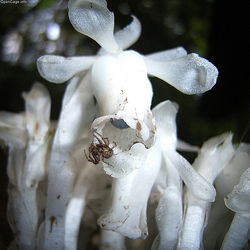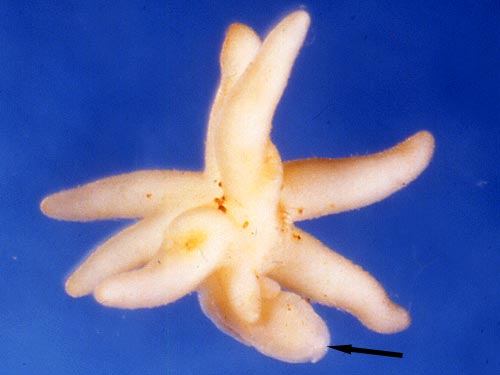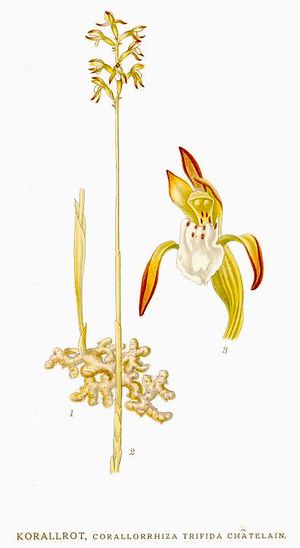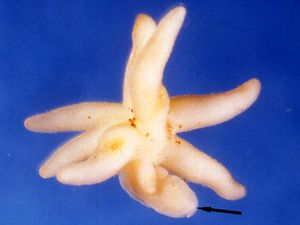Mycoheterotrophy: Difference between revisions
(→Niche) |
|||
| Line 74: | Line 74: | ||
==Key Microorganisms== | ==Key Microorganisms== | ||
<b>What specific kinds of microbes are typically involved in this interaction? Or associated with important processes? Describe key groups (genera, species) of microbes that we find in this environment, and any special adaptations they may have evolved to survive in this environment. | <b>What specific kinds of microbes are typically involved in this interaction? Or associated with important processes? Describe key groups (genera, species) of microbes that we find in this environment, and any special adaptations they may have evolved to survive in this environment. | ||
List examples of specific microbes that represent key groups or are associated with important processes found in this environment. Add sections/subsections as needed. | List examples of specific microbes that represent key groups or are associated with important processes found in this environment. Add sections/subsections as needed. | ||
Revision as of 22:52, 5 April 2011
Introduction
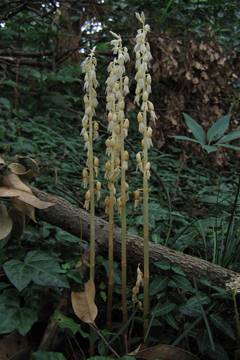
Mycoheterotrophy is the process by which plants, either wholly or partially achlorophyllous, sustain a heterotrophic metabolism via a fungal partner that provides a source of carbon and mineral nutrients. Mycoheterotrophic plants are considered parasites of their fungal hosts, which are often--but not invariably--associated with the roots of a fully autotrophic plant.
Plants are often obligately mycoheterotrophic, with stunted root systems, degenerated vascular tissue, little or no photosynthetic capacity, and "dust-seeds" that contain a fungal inocula but little or no carbon reserves. The mycoheterotrophic plant-fungal relationship is unique inasmuch as in mutualistic mycorrhizal associations plants are the carbon source while the fungi provide mineral nutrients (primarily phosphorus and nitrogen).
While the effects of obligate mycoheterotrophs are not usually measured on the ecosystem scale, some evidence exists that adult plants can facilitate the recruitment of proximal conspecific seedlings by supplementing their carbon demand through a common mycelial network (i.e., the "wood-wide web"). This process of positive-feedback is thought to be responsible for the establishment of monoculture forest patches dominated by ectomycorrhiza plant species, even within a diverse matrix of surrounding forest. This transitive dependence on an external carbon source is termed mixotrophy.
Mycoheterotrophic plants occur in a diverse and unclustered group of plants, which include liverworts, ferns, and monocot (ex. in the order Orchidales) and some dicot (ex. in the family Monotropideae) angiosperms. The fungal hosts include highly specific functional groups of ectomycorrhiza from the orders Basidiomycota and Ascomycota, sometimes called monotropid and orchid mycorrhizas, as well as some arbuscular mycorrhizas from the order Glomeromycota.
Note that mycoheterotrophy is distinct from the direct plant-plant parasitism that results when plant parasites (ex. mistletoe) develop haustorium that tap directly into a host plant's vascular tissue.
Biological interaction

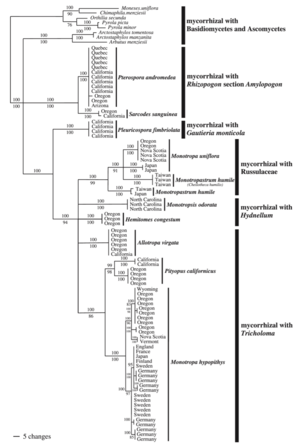
Provide details of the symbiosis or biological interaction. Is this a specific or general interaction? How do these interactions influence the host or other microbial populations, and their activities? How do these interactions influence other organisms (positive or negative influences)? What is the outcome of this interaction? Are there ecological consequences? Describe biological interactions using as many sections/subsections as you require. Look at other topics available in MicrobeWiki. Create links where relevant.
Mycoheterotrophic plants are very host specific. While it was once believed that they associated with non-mycorrhizal fungi, which obtain carbon from the decomposition of dead plant material, it is now known that mycoheterotrophs parasitize mycorrhizas that obtain carbon from host-plant photosynthate (Leake 2005). Mycoheterotrophs are often associated with patches of ectomycorrhizal plants, which sustain the fungal host with a source of carbon, facilitating the production of a soil mycelial network.
These mycelia can interact with mycoheterotrophic roots, which have a specialized root-ball morphology. The plant root-balls are encapsulated by a hyphal sheath similar to those characteristic of the plant-ectomycorrhizal interface. However, the Hartig net, which acts as the source of carbon and nutrient exchange in mutualistic ectomycorrhizas, does not penetrate beyond the mycoheterotrophic epidermis. This morphological difference effects a unidirectionality of carbon flow through the mycelial network, making the mycoheterotroph exclusively a carbon sink.
Considering their total dependence of on fungal carbon, and maximum adult sizes of up to 2 meters tall (Pterospora andromedea) and masses of several kilograms (Sarcodes sanguinea, see photo above), mycoheterotrophs must consume a substantial proportion of the photosynthate transferred to ectomycorrhizas. While the effect on both the fungus and ectomycorrhizal host plants should be negative, it is not clear that this is ecologically relevant.
Mycoheterotrophy can be entirely obligate, or else partial, in which case it is called "Mixotrophy". Plants in these categories can be distinguished by their dependence on fungal inoculation, a morphological basis, and 13C/12C isotopic signature.
Obligate mycoheterotrophy
Obligate mycoheterotrophs are totally acholorophyllous. They obtain 100% of their carbon from their fungal hosts. The order Orchidales contains the most fully mycoheterophic individuals. Similarly the ericaceous subfamily Monotropoideae, Truridaceae, Petrosaviaceae, and Corsiaceae are entirely mycoheterotrophic.
Mixotrophy
Plants that either (1) maintain some stem and/or leaf photosynthetic capacity (partial mycoheterotrophy) or (2) receive supplemental carbon from a common mycelial network (facultative mycoheterotrophy) in order to tolerate the shady understory are called mixotrophs.
Partial Mycoheterotrophy
Many mixotrophs maintain some photosynthetic capacity. Thus, their total carbon acquisition is derived simultaneously from the atmosphere (CO2) and their fungal host. Several plant families contain genera that represent several different trophic strategies.
Plants in the family Orchidioideae range along a continuous spectra from full autotrophy ("green orchids"), intermediate mixotrophs (including members of the genera Cephalanthera and Epipactis), to the obligate mycoheterotrophs. Burmanniaceae contains a mix of mycoheterotroph and mixotrophs. Gentianaceae is mostly autotrophic, but with about 30 mycoheterotroph genera (e.g. Obolaria and Bartonia)
Facultative Mycoheterotorphy
Plants that form a classical ectomycorrhizal colonization can receive supplemental carbon from the mycelial network at early life stages under the plant canopy, and then change to autotrophy in the presence of sunlight. This process is thought to be especially important in maintaing ectomonodominant tree stands--monoculture patches of ectomycorrhizal trees--within tropical forests characterized by a diverse flora of predominately arbuscular mycorrhizal tree species.
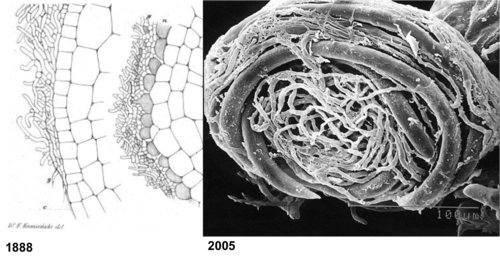
Niche
Describe the physical, chemical, or spatial characteristics of the niche where we might find this interaction, using as many sections/subsections as you require. Look at other topics available in MicrobeWiki. Create links where relevant.
Because mycoheterotrophs are dependent on their fungal hosts for carbon, they tend to be distributed around ectomycorrhizal trees. Also, as their is no competitive advantage for capturing light, they can remain in the shady understory.
Microbial processes
What microbial processes define this environment? Describe microbial processes that are important in this habitat, adding sections/subsections as needed. Look at other topics in MicrobeWiki. Are some of these processes already described? Create links where relevant.
Organic Carbon Transfer
Mineral Nutrient Acquisition
Key Microorganisms
What specific kinds of microbes are typically involved in this interaction? Or associated with important processes? Describe key groups (genera, species) of microbes that we find in this environment, and any special adaptations they may have evolved to survive in this environment. List examples of specific microbes that represent key groups or are associated with important processes found in this environment. Add sections/subsections as needed. Look at other microbe listings in MicrobeWiki. Are some of the groups of microbes from your environment already described? Create links to other MicrobeWiki pages where possible.
It is important to note that no fungi is specially adapted to serve as a host for a mycoheterotrophic plant. It is quite the other way around--mycoheterotrophic plants have evolved strategies to extract carbon from (predominately) mycorrhizal hosts. These hosts include three primary functional groups: Ectomycorrhizas, Arbuscular mycorrhizas, and some Saprotrophs.
Most phylogenetic work of mycoheterotrophic fungi comes from the root systems of achlorophyllous orchdis (e.g. the genera Corallorhiza, Epipogeum, Galeola, Gastrodia, Neottia, and Rhizanthella) and the family Monotropoideae (e.g. the genera Monotropa, Pterospora, and Sarcodes).
Ectomycorrhizas
Fungal hosts come primarily from the order Basidiomycota, with important families including Russulaceae, Tricholomataceae (esp. genus Tricholoma). Also common are fungi from the genus Rhizopogon, from the family Rhizopogonaceae and order Botales.
Arbuscular Mycorrhizas
Several mycoheterotrophic plant families associate with arbuscular mycorrhizal fungus. These include the Polygalaceae, Gentianaceae, Triuridaceae, Petrosaviaceae, Corsiaceae, and Burmanniaceae.
The taxonomy of arbuscular mycorrhiza is complicated.
The fungal hosts confirmed of mycoheterotrophic plants includes species of the family Glomus group A (see Morton and Benny 1990), and at least one species of the genus Gigaspora.
Saprotrophs
The debate as to whether some mycoheterotrophs obtain carbon independently or from saprotrophic fungi (decomposers) is long-standing (see Jonathon Leake's (2005) Plants parasitic on fungi: unearthing the fungi in myco-heterotrophs and debunking the ‘saprophytic’ plant myth . However, molecular tools have revealed that plants that obtain carbon from decomposing leaf litter due so through a saprotrphic fungal host.
For example, molecular methods have demonstrated that the achlorophyllous orchids Epipogeum roseum and Fulophia zollingeri associate with saprotrophic fungi from the family Coprinaceae (including Corpirnus disseminatus, Psathyrella spp., and P. candolleana) (Ogura-Tusjita and Yukawa 2008, Yamato et al. 2005). Acholorphyllous orchids are also known to associate with the fungal genus Armillaria, which are known saprotrophs and plant parasites.
Microbial processes
What microbial processes are important for this microbial interaction? Does this microbial interaction have some ecosystem-level effects? Does this interaction affect the environment in any way? Describe critical microbial processes or activities that are important in this interaction, adding sections/subsections as needed. Look at other topics in MicrobeWiki. Are some of these processes already described? Create links where relevant.
Current Research
Enter summaries of recent research here--at least three required
References
Edited by Brian Steidinger, a student of Angela Kent at the University of Illinois at Urbana-Champaign.
